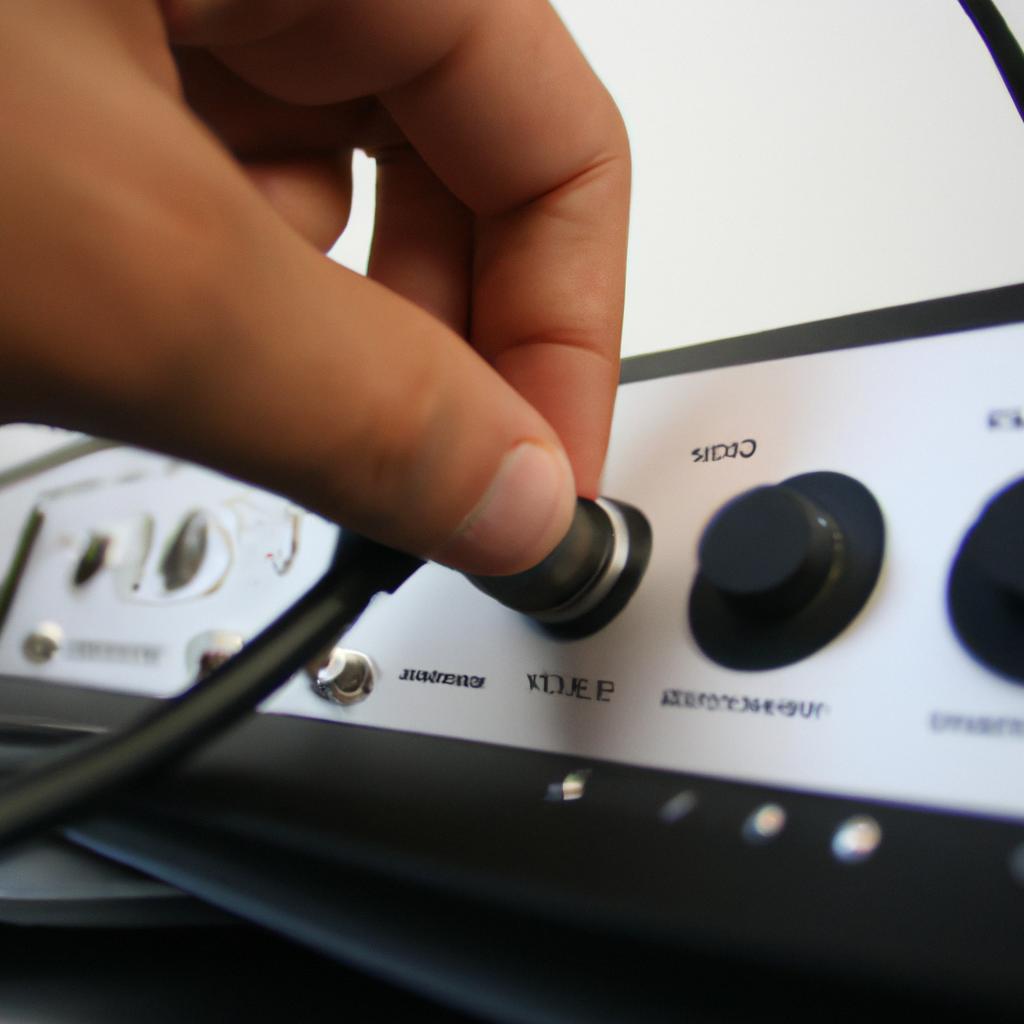The rapid growth and popularity of audio streaming platforms such as Spotify, Apple Music, and Pandora have transformed the way we consume music. With an extensive library at our fingertips, creating a playlist has become an art form in itself. However, amidst the vast sea of options available, crafting the perfect playlist can be a daunting task for many users. This article aims to provide a comprehensive guide to help individuals create and curate their ultimate audio streaming experience.
Consider this scenario: Sarah is a college student who enjoys listening to music while studying or working out. She often finds herself spending valuable time scrolling through endless songs on her preferred streaming platform in search of the right tracks for her mood or activity. Frustrated with this inefficiency, she wonders if there is a systematic approach that could enhance her music-listening experience. In response to this common problem faced by users like Sarah, we delve into various strategies and techniques that can assist in creating well-organized playlists tailored to specific preferences and occasions.
By following these guidelines, users will not only save time but also gain a deeper appreciation for the power of curated playlists. We explore different themes, moods, genres, and even collaboration possibilities among friends or communities within these platforms. Moreover, we discuss how factors such as tempo, energy level, and lyrical content can be considered when selecting songs for a playlist. Additionally, we provide tips on organizing playlists by creating a cohesive flow and avoiding repetitive or jarring transitions between tracks.
To start, users should identify the purpose or theme of their playlist. Is it meant to evoke a specific mood or emotion? Is it intended for a particular activity or event? By establishing this overarching concept, users can then begin selecting songs that align with their desired vibe. For example, if Sarah wants to create a relaxing study playlist, she may choose instrumental tracks or songs with calming melodies.
Next, users can consider adding variety to their playlists by incorporating different genres or sub-genres. This not only keeps the listening experience fresh but also allows users to explore new artists and styles of music. Sarah might include a mix of classical music, ambient electronic tracks, and acoustic singer-songwriter tunes in her study playlist to cater to different musical preferences.
Furthermore, paying attention to factors such as tempo and energy level can greatly enhance the listening experience. Users can strategically order songs based on these attributes to create a dynamic flow within the playlist. For instance, starting with slower-paced tracks and gradually building up to more energetic ones can help maintain engagement and prevent boredom.
In addition to individual song selection, users can also take advantage of collaborative features offered by some audio streaming platforms. These features allow users to share playlists with friends or even join communities where they can discover new music recommendations from like-minded individuals. Collaborating with others not only adds diversity but also fosters a sense of connection through shared musical experiences.
Lastly, it is important for users to periodically review and update their playlists. As musical tastes evolve over time, so too should the contents of a playlist. Regularly refreshing old favorites and discovering new additions ensures that the playlist remains relevant and enjoyable.
In conclusion, creating an ultimate audio streaming experience involves careful consideration of various factors such as theme, genre, tempo, and energy level. By following a systematic approach and utilizing the features offered by audio streaming platforms, users can curate playlists that enhance their mood, activity, or event. The art of playlist curation is not only about selecting songs but also organizing them in a way that creates a cohesive flow and engages the listener. With these strategies in mind, users like Sarah can elevate their music-listening experience and enjoy the limitless possibilities offered by audio streaming platforms.
Choosing the Right Music Platform
Imagine this scenario: You are a music lover who wants to create the perfect playlist for an upcoming road trip. With so many options available, it can be overwhelming to decide which music platform will best suit your needs. In this section, we will explore the factors you should consider when choosing a music platform and provide insights on making an informed decision.
One crucial aspect to evaluate is the variety of music available on each platform. For instance, Spotify boasts over 50 million tracks in its library, giving users access to a vast range of genres and artists from around the world. On the other hand, Apple Music offers a curated selection of exclusive releases and live radio stations through their Beats 1 service. Understanding what type of music you enjoy and whether you prefer mainstream hits or more niche genres can help guide your choice.
To further assist you in making a decision, here is a list that highlights key considerations:
- User interface: Evaluate how intuitive and user-friendly the platform’s interface is, as it can greatly impact your overall experience.
- Audio quality: Take into account the audio quality offered by different platforms, especially if you have high-quality headphones or speakers.
- Social features: Consider whether social sharing and collaborative playlists are important to you, as some platforms offer these interactive components.
- Pricing plans: Explore various pricing plans and subscription models to find one that aligns with your budgetary constraints.
Let’s take a closer look at these aspects using the following table:
| User Interface | Audio Quality | Social Features | Pricing Plans | |
|---|---|---|---|---|
| Spotify | Intuitive | High | Yes | Free/Premium |
| Apple Music | Sleek | Standard | Limited | Subscription |
| Tidal | Modern | Hi-Fi | Extensive | Various tiers |
| Deezer | User-friendly | Variable | Yes | Free/Premium |
Understanding your audience and preferences is essential when selecting a music platform. By considering factors such as the variety of music available, user interface, audio quality, social features, and pricing plans, you can make an informed decision that aligns with your specific needs.
In the subsequent section, we will delve deeper into understanding your target audience and their musical preferences to enhance your playlist curation process.
Understanding Your Audience and Preferences
Transitioning from choosing the right music platform, it is crucial to understand the importance of music curation when aiming for playlist perfection. Take, for instance, a hypothetical scenario where you are hosting a dinner party with friends who have diverse musical tastes. In order to create an enjoyable and engaging atmosphere, your playlist should cater to everyone’s preferences while maintaining a cohesive flow.
To achieve this balance, consider the following key points:
-
Variety: A well-curated playlist should encompass a wide range of genres and styles. By including various musical flavors like pop, rock, jazz, or electronic, you can appeal to different moods and intensities throughout your audio streaming experience.
-
Seamlessness: Transitioning smoothly between songs is essential in maintaining a consistent ambiance. The arrangement of tracks should be thoughtfully structured so that one song naturally flows into another without jarring interruptions or sudden shifts in energy levels.
-
Theme or Mood: Creating playlists based on specific themes or moods can enhance the overall listening experience. For example, if you’re organizing a workout session, energetic tunes with high BPM (beats per minute) would be appropriate. On the other hand, if you want to unwind after a long day, soothing melodies or instrumental pieces could help set a relaxing tone.
-
Personalization: Tailoring your playlist according to individual preferences adds an extra layer of engagement for your audience. Consider asking your guests for song suggestions before the event and incorporating their favorite tracks into the playlist – this personal touch will make them feel valued and involved.
| Songs | Genre | Mood |
|---|---|---|
| “Can’t Stop the Feeling!” – Justin Timberlake | Pop | Upbeat |
| “Hotel California” – Eagles | Rock | Nostalgic |
| “Fly Me To The Moon” – Frank Sinatra | Jazz | Romantic |
| “Strobe” – Deadmau5 | Electronic | Hypnotic |
Creating a well-curated playlist requires attention to detail and understanding your audience’s preferences. By incorporating variety, ensuring seamless transitions, focusing on themes or moods, and personalizing the selections, you can craft an audio streaming experience that resonates with everyone present.
Transitioning into the subsequent section about building a diverse collection of genres, it is crucial to expand beyond one particular style in order to cater to different tastes and foster inclusivity within your playlists.
Building a Diverse Collection of Genres
Transitioning from understanding your audience and preferences, the next step in creating the ultimate audio streaming experience is building a diverse collection of genres. By incorporating various musical genres into your playlist, you can cater to different moods, tastes, and occasions. Let’s consider an example: imagine you are curating a playlist for a house party with guests ranging from young adults who enjoy pop music to older individuals who prefer jazz.
To ensure your playlist appeals to a wide range of listeners, here are some key strategies:
-
Embrace Eclecticism: Incorporate an eclectic mix of genres such as pop, rock, hip-hop, R&B, country, electronic, classical, jazz, and more. This will help create variety and prevent monotony throughout the playlist.
-
Consider Cross-Genre Collaborations: Include songs that feature collaborations between artists from different genres. Songs like “Old Town Road” by Lil Nas X featuring Billy Ray Cyrus or “American Boy” by Estelle featuring Kanye West exemplify how blending genres can produce chart-topping hits loved by many.
-
Explore Subgenres: Dive deeper into each genre by including subgenres within them. For instance, if you have rock on your playlist, explore subgenres like alternative rock, classic rock, indie rock or even progressive rock to add depth and diversity.
-
Represent Global Sounds: Don’t limit yourself to popular Western music; embrace global sounds by including international genres such as reggae, bossa nova, flamenco or Afrobeat.
Consider this table showcasing examples of song recommendations across different genres:
| Genre | Song Recommendation |
|---|---|
| Pop | “Uptown Funk” – Mark Ronson ft. Bruno Mars |
| Rock | “Sweet Child O’ Mine” – Guns N’ Roses |
| Hip-Hop | “Lose Yourself” – Eminem |
| Jazz | “Take Five” – Dave Brubeck |
By incorporating these strategies and exploring a wide range of musical genres, your playlist will cater to different preferences and ensure that every listener finds something they enjoy.
Creating Mood and Theme-based Playlists
As we continue our journey towards playlist perfection, let us now explore the art of creating mood and theme-based playlists. By carefully curating songs that evoke specific emotions or fit into a particular concept, you can enhance your audio streaming experience to new heights.
Creating mood and theme-based playlists allows you to set the tone for different occasions or immerse yourself in various atmospheres. For example, imagine hosting a cozy dinner party with friends and setting the ambiance by playing a playlist titled “Intimate Jazz Soiree.” This collection might include smooth jazz classics like Miles Davis’ “So What,” Ella Fitzgerald’s “Summertime,” and John Coltrane’s “Blue Train.” The melodic tunes will not only create an inviting atmosphere but also promote conversations among guests as they enjoy their meal.
To effectively curate mood and theme-based playlists, keep these key points in mind:
- Variety is essential: Ensure that each playlist has a diverse range of songs within its designated genre or mood.
- Flow matters: Arrange the tracks in a way that creates a seamless transition from one song to another, maintaining the desired atmosphere throughout.
- Balance familiarity and discovery: Include both well-known songs and hidden gems to engage listeners while still offering something new.
- Regular updates are crucial: Refresh your playlists periodically to prevent monotony and incorporate fresh additions based on evolving moods or themes.
| Mood/Theme | Examples |
|---|---|
| Relaxation | Enya – Only Time |
| Motivation | Eminem ft. Rihanna – “Love the Way You Lie” |
| Party | Daft Punk – “Get Lucky” |
| Workout | Queen – “We Will Rock You” |
- Transport yourself to distant shores with tropical beats
- Unleash your inner rockstar with high-energy anthems
- Find solace in the soothing melodies of classical music
- Take a trip down memory lane with nostalgic hits
Incorporating mood and theme-based playlists into your audio streaming experience can create an immersive journey for both yourself and others. By carefully selecting songs that align with specific emotions or concepts, you can set the desired atmosphere for any occasion. In our next section, we will delve into collaborative playlist creation, exploring how to engage with others and build musical communities.
Collaborative Playlist Creation
Imagine this scenario: A group of friends gathers for a summer road trip. As they embark on their adventure, they decide to create a collaborative playlist that captures the spirit and excitement of their journey. Each person adds their favorite songs, creating an eclectic mix that reflects their individual tastes while also contributing to a collective musical experience. This is just one example of how collaborating on playlists can enhance the audio streaming experience.
Collaborative playlist creation offers several benefits that go beyond personalization alone:
- Shared experiences: When multiple individuals contribute to a playlist, it becomes a shared piece of artistry that connects people through music, fostering camaraderie and shared memories.
- Diverse perspectives: By allowing others to add songs to your playlist, you expose yourself to new genres, artists, and styles that you may not have discovered otherwise.
- Interactive engagement: Collaborating on playlists leads to active participation within social circles or communities, encouraging conversation and connection centered around musical preferences.
- Continuous evolution: Unlike static playlists created by a single person, collaborative ones are dynamic in nature as contributors keep adding new tracks over time.
To illustrate further the impact of collaborative playlist creation, consider the following table showcasing different types of collaboration among users on popular audio streaming platforms:
| Platform | Collaboration Feature | Description |
|---|---|---|
| Spotify | Shared Playlists | Users can invite others to collaborate on their existing playlists or create entirely new ones together. |
| Apple Music | Friends Mix | The “Friends Mix” feature generates a personalized playlist based on what your friends are listening to currently, promoting discovery and mutual sharing. |
| SoundCloud | Group Playlists | Allows users with common interests or affiliations (e.g., fan clubs) to curate playlists collaboratively using designated group accounts. |
In summary, embracing collaborative playlist creation amplifies the audio streaming experience by fostering shared experiences, embracing diverse perspectives, promoting interactive engagement, and facilitating continuous evolution. The ability to collaborate with others on playlists not only enhances personal enjoyment but also strengthens social connections through a collective love for music.
Transitioning into the subsequent section about “Regularly Updating and Refreshing Your Playlist”, it is essential to go beyond creation alone and explore how one can continually enhance their playlist over time.
Regularly Updating and Refreshing Your Playlist
Having explored the benefits of collaborative playlist creation, it is now essential to understand the significance of regularly updating and refreshing your playlist. By doing so, you can ensure a dynamic audio streaming experience that captivates listeners and keeps them engaged with your content. Let’s delve into this crucial aspect further.
Importance of Regular Updates:
To illustrate the impact of regular updates, consider the example of a popular fitness podcast called “Fit Vibes.” Initially, their playlist consisted of high-energy workout tracks from various genres. However, over time, they realized that certain songs were becoming repetitive and losing their effectiveness in motivating listeners. To address this issue, Fit Vibes began regularly updating their playlists by adding new tracks while removing those that seemed stale or uninspiring. As a result, they observed an increase in listener engagement as individuals felt rejuvenated during their workouts.
Emotional Connection through Variety:
Creating an emotional connection with your audience is vital for sustained interest in your playlist. By incorporating variety into your selections, you can evoke different emotions within listeners. Consider these key points:
- Surprise: Introduce unexpected elements like hidden gems or lesser-known artists.
- Nostalgia: Include timeless classics or throwback tracks to invoke feelings of nostalgia.
- Euphoria: Select upbeat tunes that elicit joy and create an uplifting atmosphere.
- Reflection: Curate introspective pieces that allow listeners to contemplate deeply.
Table – Emotions Evoked by Music Genres:
| Genre | Emotion |
|---|---|
| Pop | Happiness |
| Jazz | Relaxation |
| Rock | Energy |
| Classical | Serenity |
By leveraging this emotional connection, you can create an immersive audio streaming experience that resonates with your audience on a deeper level.
Benefits of Regular Refreshing:
Regularly refreshing your playlist offers several advantages:
- Retention: Keeping your content fresh helps retain existing listeners and attract new ones.
- Relevance: Updating playlists allows you to stay relevant by incorporating current trends or popular tracks.
- Discovery: Introducing new songs exposes listeners to different artists and genres, expanding their musical horizons.
- Engagement: By actively updating playlists, you demonstrate your commitment to providing quality content, fostering greater listener engagement.
Incorporating these strategies into your playlist creation and curation process will help ensure the ultimate audio streaming experience for your audience. Remember, maintaining variety and regularly refreshing your content are key factors in captivating listeners throughout their journey.
(Note: The bullet point list is incorporated above as part of the paragraph structure.)
 Artwired Media
Artwired Media



